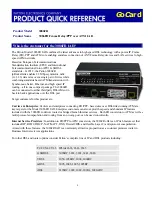
Use VLANS for Traffic Segmentation
51
ProSAFE Gigabit Web Managed (Plus) Switches
5.
Enter the switch’s password in the
password
field.
The switch’s default password is
password
.
The Switch Status page displays.
6.
Select
VLAN > 802.1Q > Advanced > VLAN Membership
.
You can select
VLAN Membership
only if you already enabled the advanced 802.1Q
VLAN option (see
Create 802.1Q-Based VLANs in an Advanced Configuration
The previous figure is an example. Your switch might provide more or less ports.
7.
In the
VLAN Identifier
menu, select the VLAN.
8.
Select the ports that you want to add to the VLAN by doing the following:
a.
(Optional) In the
Group Operation
menu, select
Untag All
,
Tag all
, or
Remove all
.
All ports are either added to the VLAN (tagged or untagged) or removed from the
VLAN.
b.
Select individual ports and assign them as tagged (T) or untagged (U) ports or
remove individual ports by selecting the check box under the port numbers.
By default, all ports are untagged.
c.
Click the
APPLY
button.
Your settings are saved. In the VLAN Membership table, the ports display as
members of the VLAN.
9.
To select ports for another VLAN, repeat
10.
To verify your selections, select
VLAN > 802.1Q > Advanced > VLAN Configuration
.
The Advanced 802.1Q VLAN Status page displays. In the VLAN Identifier Setting table,
the ports display next to the VLAN or VLANS to which they were added.
Specify a Port PVID for an 802.1Q-Based VLAN
A default port VLAN ID (PVID) is a VLAN ID tag that the switch assigns to data packets it
receives that are not already addressed (tagged) for a particular VLAN. If you connected a
computer on port 6 and you want it to be a part of VLAN 2, configure port 6 to automatically
add a PVID of 2 to all data received from the computer. This step ensures that the data from
the computer on port 6 can be seen only by other members of VLAN 2. You can assign only
one PVID to a port.
















































